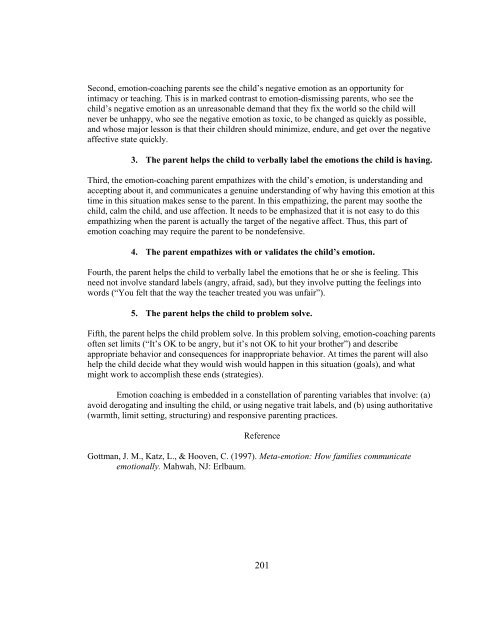Sample A: Cover Page of Thesis, Project, or Dissertation Proposal
Sample A: Cover Page of Thesis, Project, or Dissertation Proposal
Sample A: Cover Page of Thesis, Project, or Dissertation Proposal
You also want an ePaper? Increase the reach of your titles
YUMPU automatically turns print PDFs into web optimized ePapers that Google loves.
Second, emotion-coaching parents see the child‘s negative emotion as an opp<strong>or</strong>tunity f<strong>or</strong><br />
intimacy <strong>or</strong> teaching. This is in marked contrast to emotion-dismissing parents, who see the<br />
child‘s negative emotion as an unreasonable demand that they fix the w<strong>or</strong>ld so the child will<br />
never be unhappy, who see the negative emotion as toxic, to be changed as quickly as possible,<br />
and whose maj<strong>or</strong> lesson is that their children should minimize, endure, and get over the negative<br />
affective state quickly.<br />
3. The parent helps the child to verbally label the emotions the child is having.<br />
Third, the emotion-coaching parent empathizes with the child‘s emotion, is understanding and<br />
accepting about it, and communicates a genuine understanding <strong>of</strong> why having this emotion at this<br />
time in this situation makes sense to the parent. In this empathizing, the parent may soothe the<br />
child, calm the child, and use affection. It needs to be emphasized that it is not easy to do this<br />
empathizing when the parent is actually the target <strong>of</strong> the negative affect. Thus, this part <strong>of</strong><br />
emotion coaching may require the parent to be nondefensive.<br />
4. The parent empathizes with <strong>or</strong> validates the child’s emotion.<br />
Fourth, the parent helps the child to verbally label the emotions that he <strong>or</strong> she is feeling. This<br />
need not involve standard labels (angry, afraid, sad), but they involve putting the feelings into<br />
w<strong>or</strong>ds (―You felt that the way the teacher treated you was unfair‖).<br />
5. The parent helps the child to problem solve.<br />
Fifth, the parent helps the child problem solve. In this problem solving, emotion-coaching parents<br />
<strong>of</strong>ten set limits (―It‘s OK to be angry, but it‘s not OK to hit your brother‖) and describe<br />
appropriate behavi<strong>or</strong> and consequences f<strong>or</strong> inappropriate behavi<strong>or</strong>. At times the parent will also<br />
help the child decide what they would wish would happen in this situation (goals), and what<br />
might w<strong>or</strong>k to accomplish these ends (strategies).<br />
Emotion coaching is embedded in a constellation <strong>of</strong> parenting variables that involve: (a)<br />
avoid derogating and insulting the child, <strong>or</strong> using negative trait labels, and (b) using auth<strong>or</strong>itative<br />
(warmth, limit setting, structuring) and responsive parenting practices.<br />
Reference<br />
Gottman, J. M., Katz, L., & Hooven, C. (1997). Meta-emotion: How families communicate<br />
emotionally. Mahwah, NJ: Erlbaum.<br />
201




![[Sample B: Approval/Signature Sheet] - George Mason University](https://img.yumpu.com/21978828/1/190x245/sample-b-approval-signature-sheet-george-mason-university.jpg?quality=85)


![[Sample B: Approval/Signature Sheet] - George Mason University](https://img.yumpu.com/18694905/1/190x245/sample-b-approval-signature-sheet-george-mason-university.jpg?quality=85)






![[Sample B: Approval/Signature Sheet] - George Mason University](https://img.yumpu.com/18694552/1/189x260/sample-b-approval-signature-sheet-george-mason-university.jpg?quality=85)

![[Sample B: Approval/Signature Sheet] - George Mason University](https://img.yumpu.com/18694474/1/190x245/sample-b-approval-signature-sheet-george-mason-university.jpg?quality=85)
